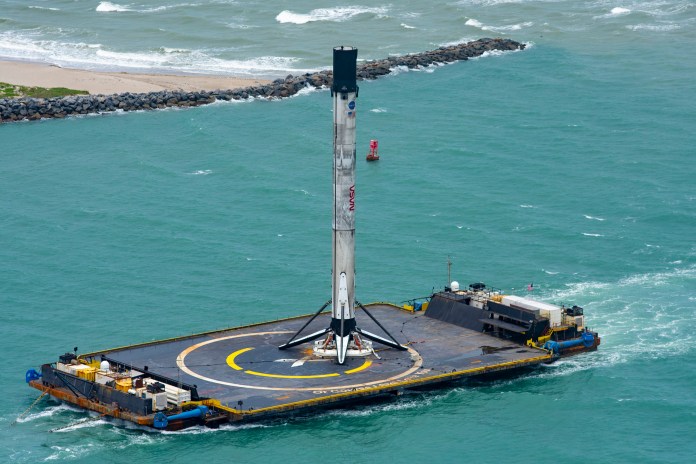The first stage of the SpaceX Falcon 9 rocket that launched the Demo-2 mission on May 30, 2020, arrives in Florida’s Port Canaveral on June 2, 2020. The same booster will launch the ANASIS-II military communications satellite for South Korea on July 14.
(Image: (C) SpaceX via Twitter)
The SpaceX rocket that launched the company’s first astronaut mission for NASA last month fired up its engines once more Saturday (July 11) in a test that sets the stage for the launch of South Korea’s first military satellite this week.
The Falcon 9 rocket ignited its nine first-stage Merlin engines briefly in a so-called static fire test at Space Launch Compex-40 of the Cape Canaveral Air Force Station in Florida. The standard SpaceX rocket test clears the way for the planned launch of the Anasis-II military communications satellite for the South Korean government on Tuesday (July 14) at 5 p.m. EDT (1700 GMT).
“Static fire test complete – targeting July 14 for Falcon 9 launch of ANASIS-II from SLC-40 in Florida,” SpaceX wrote in a Twitter update. The same Falcon 9 first stage launched NASA astronauts Bob Behnken and Doug Hurley to the International Space Station on Demo-2, SpaceX’s first-ever crewed spaceflight, on May 30, SpaceX added.
The rocket test occurred the same day as a planned SpaceX launch of a different Falcon 9 rocket carrying 57 Starlink internet satellites and two BlackSky Global Earth-imaging satellites form the nearby Pad 39A launch site at NASA’s Kennedy Space Center. SpaceX called off that launch on Saturday morning citing the need for more rocket checks.
Built by Airbus Defence and Space, Anasis-II has been billed as South Korea’s first military satellite and is designed to “provide secured communications over wide coverage,” according to Airbus.
The new satellite is based on Airbus’ Eurostar E3000 satellite platform and will be launched into a geostationary orbit, Airbus added. Geostationary orbits allow satellites to maintain a position over the same part of Earth at an altitude of about 22,000 miles (36,000 kilometers).
According to Spaceflight Now, Anasis-II was formerly known as KMilSatCom. Until this mission, South Korea has relied on civilian-owned and international satellites for communications needs, Spaceflight Now added.
Email Tariq Malik at tmalik@space.com or follow him @tariqjmalik. Follow us @Spacedotcom, Facebook and Instagram.
Join our Space Forums to keep talking space on the latest missions, night sky and more! And if you have a news tip, correction or comment, let us know at: community@space.com.
– Advertisement –
